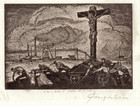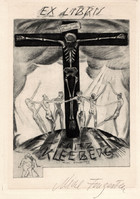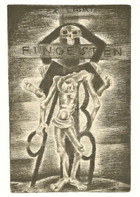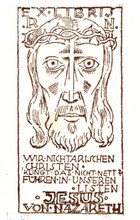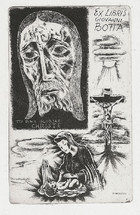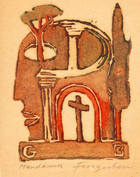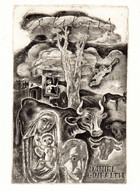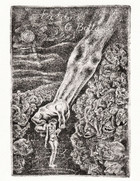Michel Fingesten
(1884-1943)
Ex libris prints are a “hidden” art form, designed not for public show but for the inside of book covers. Erotic themes have been especially prized by book plate collectors. The pint-sized prints also proved the perfect vehicle for politically subversive subjects, more easily produced and circulated than standard graphic works. Michel Fingesten was a master of both erotica and social satire in over 1500 book plate and small format prints. Working in an expressionist-surrealist style, he depicted the rise of Fascism in Europe between the two World Wars, incorporating religious symbols into macabre imagery of sex and death.
Born in 1884 as Michal Finkelstein to a Czech-Jewish father and Italian-Jewish mother in the Silesian region of the Habsburg Empire, he studied art with Oskar Kokoschka at the Vienna Academy, leaving after two years on a journey around the world that took him to America, where he witnessed the San Francisco earthquake of 1906. He returned to Europe by way of Australia, making his way across Italy to Germany to resume art studies in Munich. Fingesten settled in Berlin in 1913. He embraced the New Secession expressionist movement, gaining recognition for bitingly satiric prints. He fled to Italy in 1935, after the Nazi regime condemned his style of work as “degenerate art."
The Jewish book plate maker used Christian Crucifixion motifs in ironic ways to symbolize social injustice and systemic violence. An ex libris from World War I shows gaunt workers dragging a crucifix mounted on a gun carriage while smokestacks belch from militarized industries, reminding us how ruling elites on all sides claimed the blessing of the Church on their war efforts. In a 1918 print, nude figures celebrate the end of the war in a circle dance around a skeleton, crucified beneath the Latin marker: "Let death perish and life bloom." As the continent plunged into armed conflict a second time, Fingesten created a ghoulish Crucifixion scene, where Death takes down from the Cross a limp, loin-clad figure, propped up by the numerals for the invasion year, 1939.
Like Marc Chagall, his contemporary, Fingesten viewed Jesus as a prototype of the Suffering Jew. He seems to have been interested in a type of “Christian Judaism.” In a book plate, probably dating from around 1935, he mocked Nazi racial “purity” laws, which classified Jewish converts to Christianity as “non-Aryan” Christians, subject to the same sanctions as other Jews. Beneath a portrait of Christ as the Man of Sorrows, Fingesten composed a scathing rhymed couplet, which reads in free translation: We, non-Aryan Christians/---that sounds so droll!--/count Jesus of Nazareth on our membership roll.
A similarly anguished image of Jesus as “King of Glory” appears on a 1938 book plate showing Christ’s birth in Bethlehem and death at Golgotha. The Christian motifs come with a hopeful sunburst in this ex libris created for the Italian collector, Giovanni Botta, a key client for Fingesten after he settled in Milan. Classical columns and the Cross seem to meld in the human psyche in an undated semi-abstract woodcut also made, judging from the initials, for Botta. In a surrealist nativity scene on a 1940 book plate, a female nude is framed in the window of a villa with Joseph, Mary, the Baby Jesus, and the animals at the manger in the foreground.
Seemingly safe in Milan, Fingesten was haunted by his identity as one of "the chosen," reflected in an undated ex libris, where a heavenly hand reaches for a solitary figure in a deathscape of grotesque faces. He was arrested in a round-up of Jewish “aliens” in 1940 and sent to the Ferramonti internment camp in Calabria, where he was liberated by Allied forces in 1943. A priest in the nearby village of Bisignano took Fingesten in and commissioned a painting of the Martyrdom of St. Bartholomew. The artist completed the wood panel piece in just over a week, calling it “a drama in two faces,” pairing the executioner with the executed. It would be his last work. Fingesten died several days later from complications, following emergency surgery.
